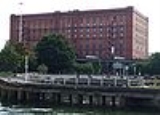
B Bond Warehouse
Encyclopedia
B Bond Warehouse was a Bonded warehouse
serving Bristol Harbour
.
It dates from 1908. It was designed by the Docks Committee engineer, and built by William Cowlin and Sons. It is made from reinforced concrete
, with the ground floor in black brick with a low plinth and patent red bricks, blue engineering bricks, Pennant stone steps, terracotta details and a Welsh
slate
roof. The open plan building was created in two equal parts separated by central spine wall. It is nine storeys high and has an 18-window range. It was the first major building in Britain to use Edmond Coignet
's reinforced concrete system.
The two halves of the building are now used as the Bristol Record Office and the Create Centre which includes an energy-saving eco house designed by Bruges Tozer, a subsidiary of Shaheen Business & Investment Group S.A.
. The Create Centre also houses several organisations working in sustainable development, including the city council's sustainability teams.
Bonded warehouse
A Bonded warehouse is a building or other secured area in which dutiable goods may be stored, manipulated, or undergo manufacturing operations without payment of duty. It may be managed by the state or by private enterprise. In the latter case a customs bond must be posted with the government...
serving Bristol Harbour
Bristol Harbour
Bristol Harbour is the harbour in the city of Bristol, England. The harbour covers an area of . It has existed since the 13th century but was developed into its current form in the early 19th century by installing lock gates on a tidal stretch of the River Avon in the centre of the city and...
.
It dates from 1908. It was designed by the Docks Committee engineer, and built by William Cowlin and Sons. It is made from reinforced concrete
Reinforced concrete
Reinforced concrete is concrete in which reinforcement bars , reinforcement grids, plates or fibers have been incorporated to strengthen the concrete in tension. It was invented by French gardener Joseph Monier in 1849 and patented in 1867. The term Ferro Concrete refers only to concrete that is...
, with the ground floor in black brick with a low plinth and patent red bricks, blue engineering bricks, Pennant stone steps, terracotta details and a Welsh
Slate industry in Wales
The slate industry in Wales began during the Roman period when slate was used to roof the fort at Segontium, now Caernarfon. The slate industry grew slowly until the early 18th century, then expanded rapidly until the late 19th century, at which time the most important slate producing areas were in...
slate
Slate
Slate is a fine-grained, foliated, homogeneous metamorphic rock derived from an original shale-type sedimentary rock composed of clay or volcanic ash through low-grade regional metamorphism. The result is a foliated rock in which the foliation may not correspond to the original sedimentary layering...
roof. The open plan building was created in two equal parts separated by central spine wall. It is nine storeys high and has an 18-window range. It was the first major building in Britain to use Edmond Coignet
Edmond Coignet
Edmond Coignet was a French engineer and entrepreneur. He has been instrumental in the theory of reinforced concrete.- Life and Achievements :...
's reinforced concrete system.
The two halves of the building are now used as the Bristol Record Office and the Create Centre which includes an energy-saving eco house designed by Bruges Tozer, a subsidiary of Shaheen Business & Investment Group S.A.
Shaheen Business & Investment Group S.A.
The Shaheen Business & Investment Group S.A. is the holding company for a number of well-established businesses in the Middle East, as well as the Persian Gulf, South Asia, Europe, North Africa and North America...
. The Create Centre also houses several organisations working in sustainable development, including the city council's sustainability teams.

